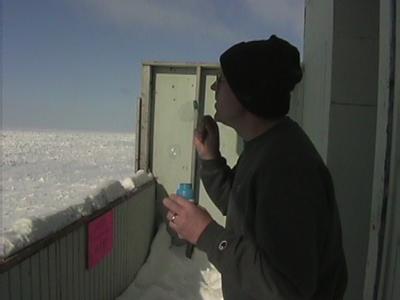11 April, 2003
Bitter Cold
After several days of being spoiled with warm
temperatures (20 to 30 degrees F) and relatively no
winds the weather has quickly changed, typical for
this region.
Air temperatures are hovering just above single digits
and the winds are blowing steadily at 15 mph and
gusting up to 30 mph creating a wind chill of 5 to 10
degrees below 0 F.
The winds make a howling sound around the sides of
the building like someone blowing across a bottle,
carrying small crystals of snow and ice that sparkle
like glitter in the sunlight. A snowstorm is expected
by the weekend when the winds shift and begin blowing
out of the south. Fortunately the pump is functioning
well, water is flowing into the shack and data is
being collected so there is no real need to work
outside. Although Jim and I did venture out for about
thirty minutes to check on the pump hose on the ice
and even for that short amount of time the frigid air
stung our faces.
The unexpected downtime has allowed me the
opportunity to conduct two experiments that were sent
with me by the first graders and fourth graders from
my school. Both classes had questions and each asked
me to perform a task and report back my observations.
Since other students who e-mailed me have asked both
of these questions I have decided to share the
observations with everyone.
First grade question
Will bubbles freeze and break like glass in really
cold temperatures?
Materials used were an 8-ounce bottle of liquid bubble
soap and a small bubble wand.
The time the experiment was conducted was six-thirty
in the evening. The weather was cold, 10 degrees F
with a wind chill of minus 18 degrees F with clear
sunny clear skies. I conducted the experiments behind
the school and blocked from the wind.
Procedure
As per instructions I attempted to blow the bubbles
and observe what happened. Immediately a problem
occurred. The bubble mixture was freezing before a
bubble could be blown. My solution to the problem was
to keep breathing on the bubble solution in the wand
to keep it warm then attempt to blow the bubble. It
worked and I was able to get 1 to 2 bubbles each time.
Observations
Once the bubbles left the wand they quickly floated
upward but after 3 to 5 seconds they began to fall
rapidly. When they popped they broke into 2 to 3
threadlike pieces that fell to the ground. I repeated
the experiment ten times. Eight out of the ten
produced bubbles that popped with the threadlike
pieces. The other two popped before they left the
wand.
Good luck with your investigation and interpretations!
Fourth grade question
My mom always yells at me to dry my hair before I
go outside in the winter because it will freeze and
break off if I do not. Will your hair really freeze
and break?
No materials were used other than wet hair for this
experiment.
Procedure
I soaked a four-inch section of hair that I had formed
into a spike on my head then walked outside for about
30 seconds until the hair froze. I then tried to break
the hair by bending and pulling on it. I repeated the
test 10 times.
Observations
Although the hair seemed to freeze fairly stiff it
would not break. (Sorry moms)
See if you can figure out why the hair would not
break!

First grade bubble experiment

I am wild about this fourth grade science experiment!
Contact the TEA in the field at
.
If you cannot connect through your browser, copy the
TEA's e-mail address in the "To:" line of
your favorite e-mail package.
|
